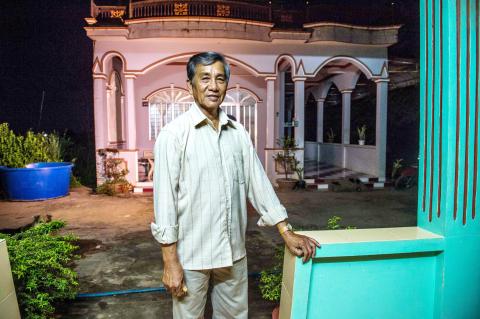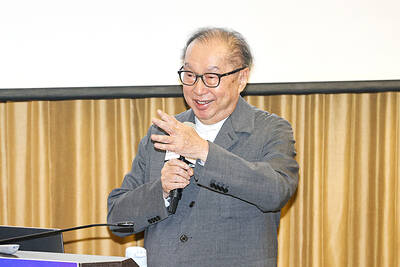With a flashy gold watch and a chunky matching ring, Tang Van Cuol looks a far cry from the average Vietnamese farmer as he slings back a shot of rice wine and boasts about his projected earnings.
After years scratching a living growing rice and onions or farming ducks, the 54-year-old says his life was transformed in 2000 — by shrimp.
The Mekong Delta, long renowned as the “rice bowl of Vietnam,” is now also home to a multibillion-dollar shrimp industry and burgeoning numbers of farmers are building fortunes from the small crustaceans.

Photo: AFP
“Raising shrimp can bring so much income, nothing can compare,” Cuol said over lunch with friends, a healthy spread of rice, salad, pork and — of course — shrimp.
This year he expects to make 1 billion dong (US$44,000) — an enormous sum in the delta, where rice farmers make about US$100 per month.
The shrimp bonanza began in the 1990s when rising sea levels seeped saltwater into the Mekong Delta.
It has surged in parallel with demand from the US and EU.
Savvy locals were swift to spot the changing conditions were ripe for shrimp farming.
The wealth has transformed Cuol’s part of Soc Trang Province: motorbikes have replaced bicycles on newly paved roads dotted with multistory concrete homes unimaginable a generation ago.
Cuol owns several motorbikes, funded his daughter’s wedding and claims an impressive collection of antiques “worth hundreds of millions of dong.”
However, environmentalists say that the bounty from intensive shrimp farming might be short-lived.
Pollution and disease frequently lay waste to harvests.
However, a wider crisis is looming caused by the obliteration of mangrove forests to make way for farms, exposing the area to lashings from storms and further rises in sea level linked to climate change.
“This is not sustainable,” said Andrew Wyatt, Mekong Delta Program Manager at the International Union for Conservation of Nature (IUCN).
The IUCN is encouraging farmers to preserve mangroves and stop using harmful chemicals so their shrimp can be certified as organic, earning a 5 to 10 percent premium in the process.
Yet shrimp farmers say the financial rewards are too great to ignore.
Just like his father and grandfather, Tang Van Tuoi struggled as a rice farmer. He slept under a roof fashioned from coconut palms, earning just enough to support his family.
However, when saltwater started creeping into his rice fields, he saw an opportunity and started harvesting shrimp.
“Now everything is developed. We have vehicles, roads, things have changed massively,” he told reporters from his polished living room, where a flatscreen TV hangs over a wood furniture set.
Even in a bad year, he can earn more than he did as a rice farmer. In a good year he can rake in upward of US$40,000.
Flush with cash, he has built three homes for his family.
“We have money, we have enough of everything,” the father of six said as his granddaughter played on a smartphone nearby.
However, he admitted that such farming is a gamble.
His ponds have been hit by disease and pollution.
Attuned to the long-term risks, the government has resisted opening the whole region to the shrimp industry even as seawater continues to seep further inland.
Instead, authorities have ploughed millions of US dollars into sealing off freshwater zones needed to grow rice — the nation’s staple — throughout the Mekong Delta.
The strategy is in part to ensure the region can grow enough rice to feed the country, a historic pillar of the communist government’s centrally planned economy.
However, as the country has embraced market reforms, the lure of exporting shrimp has become increasingly attractive.
This year, Vietnamese Prime Minister Nguyen Xuan Phuc called for shrimp exports to reach US$10 billion by 2025, a jump from US$3 billion last year.
In parallel, export earnings from rice have steadily declined since 2011, bringing in US$2.2 billion last year.
“They’re trying to thread a needle between making money off of exports and economic development, but also not sacrificing long-term food security,” Cornell University doctoral researcher Tim Gorman said.
As a result, policies both encourage the quick cash generated by shrimp farms and protect the long-term future of the rice crop.
That can seem contradictory or haphazard to farmers.
In some areas, the government is urging farmers to grow rice half the year and harvest shrimp for the other half — a hard sell to farmers like Thach Ngoc Cuong who are eager to abandon rice.
He has two plots in Soc Trang Province, one contains freshwater for rice, the other is salty for the prized crustaceans.
“I would be very happy if we could raise shrimp on the rice side,” he said.

BYPASSING CHINA TARIFFS: In the first five months of this year, Foxconn sent US$4.4bn of iPhones to the US from India, compared with US$3.7bn in the whole of last year Nearly all the iPhones exported by Foxconn Technology Group (富士康科技集團) from India went to the US between March and last month, customs data showed, far above last year’s average of 50 percent and a clear sign of Apple Inc’s efforts to bypass high US tariffs imposed on China. The numbers, being reported by Reuters for the first time, show that Apple has realigned its India exports to almost exclusively serve the US market, when previously the devices were more widely distributed to nations including the Netherlands and the Czech Republic. During March to last month, Foxconn, known as Hon Hai Precision Industry

Taiwan Semiconductor Manufacturing Co (TSMC, 台積電) and the University of Tokyo (UTokyo) yesterday announced the launch of the TSMC-UTokyo Lab to promote advanced semiconductor research, education and talent development. The lab is TSMC’s first laboratory collaboration with a university outside Taiwan, the company said in a statement. The lab would leverage “the extensive knowledge, experience, and creativity” of both institutions, the company said. It is located in the Asano Section of UTokyo’s Hongo, Tokyo, campus and would be managed by UTokyo faculty, guided by directors from UTokyo and TSMC, the company said. TSMC began working with UTokyo in 2019, resulting in 21 research projects,

Ashton Hall’s morning routine involves dunking his head in iced Saratoga Spring Water. For the company that sells the bottled water — Hall’s brand of choice for drinking, brushing his teeth and submerging himself — that is fantastic news. “We’re so thankful to this incredible fitness influencer called Ashton Hall,” Saratoga owner Primo Brands Corp’s CEO Robbert Rietbroek said on an earnings call after Hall’s morning routine video went viral. “He really helped put our brand on the map.” Primo Brands, which was not affiliated with Hall when he made his video, is among the increasing number of companies benefiting from influencer

Quanta Computer Inc (廣達) chairman Barry Lam (林百里) yesterday expressed a downbeat view about the prospects of humanoid robots, given high manufacturing costs and a lack of target customers. Despite rising demand and high expectations for humanoid robots, high research-and-development costs and uncertain profitability remain major concerns, Lam told reporters following the company’s annual shareholders’ meeting in Taoyuan. “Since it seems a bit unworthy to use such high-cost robots to do household chores, I believe robots designed for specific purposes would be more valuable and present a better business opportunity,” Lam said Instead of investing in humanoid robots, Quanta has opted to invest